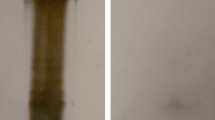Abstract
Halomonas pantelleriensis DSM9661Τ is a Gram-negative haloalkaliphilic bacterium isolated from the sand of the volcanic Venus mirror lake, closed to seashore in the Pantelleria Island in the south of Italy. It is able to optimally grow in media containing 3–15 % (w/v) total salt and at pH between 9 and 10. To survive in these harsh conditions, the bacterium has developed several strategies that probably concern the bacteria outer membrane, a barrier regulating the exchange with the environment. In such a context, the lipopolysaccharides (LPSs), which are among the major constituent of the Gram-negative outer membrane, are thought to contribute to the restrictive membrane permeability properties. The structure of the lipid A family derived from the LPS of Halomonas pantelleriensis DSM 9661T is reported herein. The lipid A was obtained from the purified LPS by mild acid hydrolysis. The lipid A, which contains different numbers of fatty acids residues, and its partially deacylated derivatives were completely characterized by means of ESI FT-ICR mass spectrometry and chemical analysis. Preliminary immunological assays were performed, and a comparison with the lipid A structure of the phylogenetic proximal Halomonas magadiensis is also reported.




Similar content being viewed by others
Abbreviations
- ESI FT-ICR:
-
Electrospray ionization Fourier transform-ion cyclotron resonance
- GC–MS:
-
Gas chromatography–mass spectrometry
- EI–MS:
-
Electron ionization–mass spectrometry
- NMR:
-
Nuclear magnetic resonance
- CID MS/MS:
-
Collision-induced dissociation
- Th1:
-
T helper 1
- Th2:
-
T helper 2
- IFN-γ:
-
Interferon-γ
- TNF-α:
-
Tumor necrosis factor-α
- IL-4:
-
Interleukin 4
- IL-10:
-
Interleukin 10
References
Alexander C, Rietschel ET (2001) Invited review: bacterial lipopolysaccharides and innate immunity. J Endotoxin Res 7:167–202
Carillo S, Pieretti G, Parrilli E, Tutino ML, Gemma S, Molteni M, Lanzetta R, Parrilli M, Corsaro MM (2011) Structural investigation and biological activity of the lipooligosaccharide from the psychrophilic bacterium Pseudoalteromonas haloplanktis TAB 23. Chem Eur J 17:7053–7060
Carillo S, Pieretti G, Lindner B, Romano I, Nicolaus B, Lanzetta R, Parrilli M, Corsaro MM (2013) The lipid A from the haloalkaliphilic bacterium Salinivibrio sharmensis strain BAGT. Mar Drugs 11:184–193
Corsaro MM, Gambacorta A, Iadonisi A, Lanzetta R, Naldi T, Nicolaus B, Romano I, Ummarino S, Parrilli M (2006) Structural determination of the O‐chain polysaccharide from the lipopolysaccharide of the haloalkaliphilic Halomonas pantelleriensis bacterium. Eur J Org Chem 1801–1808
Endo Y, Hirahara K, Yagi R, Tumes DJ, Nakayama T (2014) Pathogenic memory type Th2 cells in allergic inflammation. Trends Immunol 35:69–78
Galanos C, Lüderitz O, Westphal O (1969) A new method for the extraction of R lipopolysaccharides. Eur J Biochem 9:245–249
Holst O (1999) Chemical structure of the core region of lipopolysaccharides. In: Brade H, Opal S, Vogel S, Morrison DC (eds) Endotoxin in health and disease. Marcel Dekker, New York, pp 115–154
Holst O (2002) Chemical structure of the core region of lipopolysaccharides—an update. Trends Glycosci Glycotechnol 14:87–103
Holst O, Ulmer AJ, Brade H, Flad HD, Rietschel ED (1996) Biochemistry and cell biology of bacterial endotoxins. FEMS Immunol Med Microbiol 16:83–104
Ialenti A, Di Meglio P, Grassia G, Maffia P, Di Rosa M, Lanzetta R, Molinaro A, Silipo A, Grant W, Ianaro A (2006) A novel lipid A from Halomonas magadiensis inhibits enteric LPS-induced human monocyte activation. Eur J Immunol 36:354–360
Kim KK, Lee KC, Oh H-M, Lee J-S (2010) Halomonas stevensii sp. nov., Halomonas hamiltonii sp. nov. and Halomonas johnsoniae sp. nov., isolated from a renal care centre. Int J Syst Evol Microbiol 60:369–377
Kondakov A, Lindner B (2005) Structural characterization of complex bacterial glycolipids by Fourier transform mass spectrometry. Eur J Mass Spectrom 11:535–546
Moran AP, Lindner B, Walsh EJ (1997) Structural characterization of the lipid A component of Helicobacter pylori rough-and smooth-form lipopolysaccharides. J Bacteriol 179:6453–6463
Persing DH, Coler RN, Lacy MJ, Johnson DA, Baldridge JR, Hershberg RM, Reed SG (2002) Taking toll: lipid A mimetics as adjuvants and immunomodulators. Trends Microbiol 10:S32–S37
Pieretti G, Corsaro MM, Lanzetta R, Parrilli M, Nicolaus B, Gambacorta A, Lindner B, Holst O (2008) Structural characterization of the core region of the lipopolysaccharide from the haloalkaliphilic Halomonas pantelleriensis: identification of the biological O-antigen repeating unit. Eur J Org Chem 721–728
Pieretti G, Cipolletti M, D’Alonzo D, Alfano A, Cimini D, Cammarota M, Palumbo G, Giuliano M, De Rosa M, Schiraldi C, Parrilli M, Bedini E, Corsaro MM (2014) A combined fermentative-chemical approach for the scalable production of pure E. coli monophosphoryl lipid A. Appl Microbiol Biotechnol 98:7781–7791
Rietschel ET, Kirikae T, Schade FU, Ulmer AJ, Holst O, Brade H, Schmidt G, Mamat U, Grimmecke H-D, Kusumoto S, Zähringer U (1993) The chemical structure of bacterial endotoxin in relation to bioactivity. Immunobiology 187:169–190
Romano I, Nicolaus B, Lama L, Manca MC, Gambacorta A (1996) Characterization of a haloalkaliphilic strictly aerobic bacterium, isolated from Pantelleria island. Syst Appl Microbiol 19:326–333
Romano I, Nicolaus B, Lama L, Travaso D, Caracciolo G, Gambacorta A (2001) Accumulation of osmoprotectants and lipid pattern modulation in response to growth conditions by Halomonas pantelleriensis. Syst Appl Microbiol 24:342–352
Seydel U, Oikawa M, Fukase K, Kusumoto S, Brandenburg K (2000) Intrinsic conformation of lipid A is responsible for agonistic and antagonistic activity. Eur J Biochem 267:3032–3039
Silipo A, Lanzetta R, Amoresano A, Parrilli M, Molinaro A (2002) Ammonium hydroxide hydrolysis a valuable support in the MALDI-TOF mass spectrometry analysis of lipid A fatty acid distribution. J Lipid Res 43:2188–2195
Author information
Authors and Affiliations
Corresponding author
Additional information
Communicated by A. Oren.
Rights and permissions
About this article
Cite this article
Carillo, S., Pieretti, G., Casillo, A. et al. Structural characterization of the lipid A from the LPS of the haloalkaliphilic bacterium Halomonas pantelleriensis . Extremophiles 20, 687–694 (2016). https://doi.org/10.1007/s00792-016-0858-2
Received:
Accepted:
Published:
Issue Date:
DOI: https://doi.org/10.1007/s00792-016-0858-2




